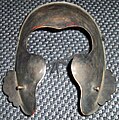| This article includes a list of general references, but it lacks sufficient corresponding inline citations. Please help to improve this article by introducing more precise citations. (August 2019) (Learn how and when to remove this message) |

Men-yoroi (面鎧), also called menpō (面頬) or mengu (面具), are various types of facial armour that were worn by the samurai class and their retainers in feudal Japan. These include the sōmen, menpō, hanbō or hanpō, and happuri.
Description
The men-yoroi, which covered all or part of the face, provided a way to secure the top-heavy kabuto (helmet). The Shinobi-no-o (chin cord) of the kabuto would be tied under the chin. Small hooks called ori-kugi or posts called odome located on various places would help secure the chin cord. The men-yoroi was constructed from iron, leather, or a combination of both. It had a lacquered or rusted type of finish and included a variety of facial details, such as a moustache, fierce teeth and a detachable nose. With the exception of the happuri, a men-yoroi had a small hole underneath the chin for sweat drainage.
History
Face armour in Japan begins with the happuri, which is depicted in Heian- and Kamakura-era yamato-e paintings and is thought to have appeared during the 10th or 11th centuries. It is depicted as being worn with or without a helmet by both mounted warriors and foot retainers. By the 14th century, the hōate appears, and according to Tom Conlan, this development is behind decreased facial wound statistics. However, others, such as Yamagishi Sumio, believe that the hōate was not widespread at that time, as it—and the later menpō—restricted the vision of the wearer. Hōate are also portrayed in art and literature of the period, most notably the Aki no yo no Nagamonogatari scroll and Taiheiki. The menpō (half-mask with detachable nosepiece) and the sōmen (full face mask) are believed to have been introduced around the mid to late 15th century, and the hanbō (chin guard) in the second half of the 16th century.
Types of men-yoroi

Sōmen
Sōmen covered the entire face.
Menpō
Menpō covered the face from the nose down to the chin.
Hanbō (hanpō)
Hanbō covered the lower face from under the nose to the chin.
Happuri
Happuri covered the forehead and cheeks.
Parts of the men-yoroi
-
Odome, an attachment post for securing the chin strap of a kabuto (helmet)
-
Ori-kugi, an attachment hook for securing the chin strap of a kabuto (helmet)
-
Ase nagashi no ana, a drain hole (or tube) for perspiration located under the chin of various mengu
-
Yodare-kake, throat guard on various mengu
See also
Notes
References
- Arms and armor of the samurai: the history of weaponry in ancient Japan, Authors Ian Bottomley, Anthony Hopson, Contributor Anthony Hopson, reprint, Publisher Crescent Books, 1993, Original from the University of Virginia, Digitized August 26, 2008, ISBN 978-0-517-10318-0 P.77,178, 186
- The Watanabe Art Museum Samurai Armour Collection (Kabuto & Mengu, Volume I Trevor Absolon (Author), Brian Snoody (Illustrator), Barry Till (Preface), Anthony J. Bryant (Editor), Trevor Absolon & Dave thatcher (Photographer), Ian Bottomley (Introduction), Ian Bottomley & Anthony J. Bryant (Foreword) Publisher(Toraba), 2011 P.234
- Samurai: The Weapons and Spirit of the Japanese Warrior, Author Clive Sinclaire, ,Publisher Globe Pequot, 2004, ISBN 978-1-59228-720-8 P.30,138
- Samurai 1550-1600, Anthony J. Bryant, Angus McBride, Osprey Publishing, 1994 p.28
- Samurai: The Weapons and Spirit of the Japanese Warrior, Author Clive Sinclaire, Publisher Globe Pequot, 2004, ISBN 978-1-59228-720-8 P.30,138
- he Watanabe Art Museum Samurai Armour Collection (Kabuto & Mengu, Volume I) Trevor Absolon (Author), Brian Snoody (Illustrator), Barry Till (Preface), Anthony J. Bryant (Editor), Trevor Absolon & Dave thatcher (Photographer), Ian Bottomley (Introduction), Ian Bottomley & Anthony J. Bryant (Foreword) Publisher(Toraba), 2011 P.234]
- ^ Oriental Armour Robinson, H. R. United States: Dover Publications. 2013 pp. 194
- State of war : the violent order of fourteenth century Japan Thomas Conlan. United States: Center for Japanese Studies, University of Michigan, 2003 pp. 65
- Nihon Kachu no Kisoteki Chishiki Yamagishi, M., Miyazaki, M. Japan: 雄山閣. 1997 pp. 118-20
- "Unidentified artist | A Long Tale for an Autumn Night (Aki no yo nagamonogatari) | Japan | Muromachi period (1392–1573)". www.metmuseum.org. Retrieved August 2, 2021.
External links
| Japanese weapons, armour and equipment | |||||
|---|---|---|---|---|---|
| Swords |
| ||||
| Knives and daggers | |||||
| Polearms and spears | |||||
| Practice weapons | |||||
| Armour |
| ||||
| Clothing | |||||
| Samurai accoutrements | |||||
| Chain and rope weapons | |||||
| Clubs and truncheons | |||||
| Staff weapons | |||||
| Projectile and throwing weapons | |||||
| Firearms and guns | |||||
| Improvised and other weapons | |||||
| Signal devices | |||||
| Users | |||||












